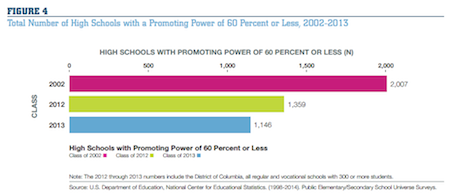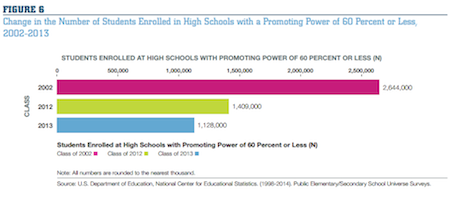Something amazing is going on with high school graduation rates. In the 1990’s public high school graduation rates actually fell, from 74 percent in 1990 to 72 percent in 2000. But in the mid-2000’s they started to rise, and they really took off after NCLB’s accountability provisions took effect in 2006. We hit an all-time high in 2009, and we’ve made new highs every year since. Today, the national high school graduation rate sits at 81 percent.
The overall trend is great, but as the 2015 Grad Nation report shows, we’re also seeing big increases for historically disadvantaged groups. In just the last two years alone, the black-white gap closed by 1.1 percentage points, and the Hispanic-white gap closed by 1.6 percentage points. We’ve seen similar progress from students with disabilities, Limited English Proficiency students, and low-income students.
Perhaps most remarkably, we’ve attacked schools with particularly poor outcomes. The number of “high school dropout factories,” where less than 60 percent of students graduate, is declining rapidly. The figure below comes from the latest Grad Nation report, and it shows that the number of dropout factories fell by 861 (43 percent) from 2002 to 2013.

We’ve seen even bigger declines in the number of students attending dropout factories. Here’s another chart from the Grad Nation report showing that in a decade we’ve reduced the number of students enrolling in dropout factories by 1.5 million students. That’s a decline of 57 percent in just 11 years.

Again, the progress is even better for certain groups of students. In 2002, 46 percent of black students were enrolled in a dropout factory. Today, that number is 19 percent. In 2002, Hispanic students had a 39 percent chance of being enrolled in a dropout factory; that’s now fallen to 12 percent.
The work is by no means complete–there are still more than 1 million students enrolled in dropout factories–but we’ve made remarkable progress.
—Chad Aldeman
This post originally appeared on Ahead of the Heard.


